|
|
|
6mm Remington Ackley Varminter
A Classic Groundhog Gun That's Deadly Accurate to 900+ yards
Other Guns of the Week >
Richard Franklin, owner of Richard's Custom Rifles in Virginia, is one serious varmint shooter. The farther the critter, the more fun it is to hit. With his favorite long-range caliber, the 6mm Remington Ackley Improved, he regularly nails groundhogs at 600 to 900+ yards. Here is his latest 6mm AI, a BAT-actioned 14-twist that drives a 75-grain V-Max at a blistering 3860 fps. With a classic-styled laminated walnut stock, this flat-shooting, hard-hitting rig delivers "maximum mist effect" even at the longest ranges.
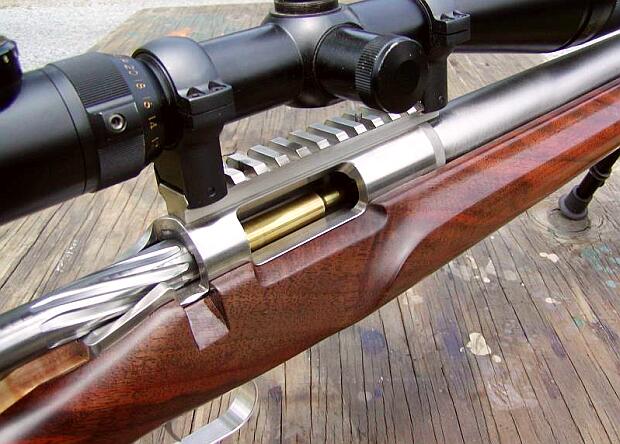
Choice of Caliber--Why the 6mm Rem AI and not a .243 Ackley
When asked why he prefers a 6mm Rem AI over the more common .243 AI, Richard replied: "I've probably built over one hundred 6mm AIs in the last three years. It's been my favorite long-range varmint cartridge for years and years. Over the years I've put together heavier-caliber rifles hoping they would be a better windy-day long-range varminter than the 6mm AI. I have always gone back to the 6mm AI because it is so hard to beat. High velocity with explosive bullets is a varmint hunter's delight (unless he is skinning out the critters). The other school of thought is to use VLD bullets at a much lower velocity (VLDs do no not like to be shot so fast). It is true that the VLDs will reach out at much longer ranges and buck the wind better, but they sometimes pass right through a critter leaving only a pencil-hole. The wounded varmint will then drag away to his den. Prairie dogs are easily killed with the VLDs due to P-dogs' small body mass, but on larger varmints, such as groundhogs and coyotes, you will get a lot of cripples. My favorite 6mm AI is set up with a 14-twist HV barrel shooting the 75gr V-max at 3800+ fps. My second favorite setup is with a 10-twist HV barrel shooting the 87gr V-Maxes. The reason the 75-grainer is my favorite is that 80% of our hogging is at ranges of 800 yards and less and the 75-grainer works its magic at these distances.
Comparing the 6mm Rem AI with the .243 chamberings, I think the 6mm Rem AI comes out on top. The 6mm AI is ALL the cartridge any varmint hunter needs. It will do anything you want to do with varmints, any kind of varmint. And in a 10-twist, it is the best 1000-yd varmint caliber you can get your hands on period. The long-necked 6mm AI will have less throat erosion than the short-necked .243 or .243 AI. The 6mm Rem AI will also hold a little more powder than a .243 Ackley. For long-range varminting, sending light bullets at ultra-high velocities, I just think the 6mm Rem has better case design than a .243 Win. With either case, definitely go with the Ackley version. The 40° shoulder gives you a little more powder capacity and both the shoulder angle and the reduced body taper give you better brass life. A case with no taper won't stretch as much as a tapered case."
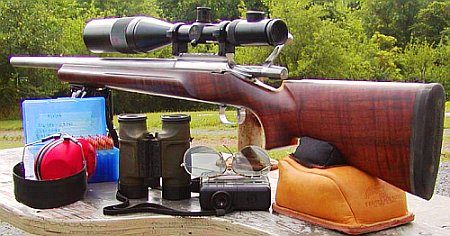 Gun Specifications Gun Specifications
Richard's rifle features a BAT Machines SV (short) RBRP action with fluted bolt, a Holland recoil lug, and a BAT +20 MOA Weaver-style scope base. Richard prefers the short action for stiffness, but this requires pulling the bolt to remove a loaded round. The stock is Richard's Model 010 in a three-layer laminate--outer layers of fancy walnut with a 5/8" center strip of curly maple. The stock is bedded with Richard's own stainless pillars (with escutchens). These pillars, one of Richard's "signature" features, are hand-made from barrel stock provided by a prominent barrel-maker. The 010 stock has a wide, stable beavertail that extends just rear of the recoil lug area for added strength in that area. The straight comb is as high as it can be made and still be able to insert a bore guide. With some actions a cut has to be made in the top forward part of the comb to allow the bolt to fully open. (Richard's Model 007 has a similar design, but with a shorter beavertail, and a roll-over comb--see photos at bottom of page). The stock has quite a bit of drop from the grip to the toe. Richard tells us, "this is important for the varminter who shoots from bipod and improvised rests. The drop makes it much easier to adjust elevation with your rear bag." The barrel is a 27" Krieger 14-twist, with six lands and grooves. A BAT trigger guard and Jewell trigger round out the component list.
For optics, Richard runs an 8-32x56 Nightforce Benchrest scope in Burris Signature Zee Rings. Why would Richard trust a $1250 scope to a relatively inexpensive set of rings? Richard explained: "The Burris Signature is the best ring design ever, in my opinion. I'll never buy another kind of ring. I've never seen 'ring rash' from the Burris Signature rings. A lot of people make money off gimmicks. The Burris Signature rings do the job better than other rings that cost two or three times as much. The Burris nylon inserts align to the scope, so they don't transfer any stress from the mounting system to your action. If conventional rings are not lapped perfectly, when you tighten them up you'll be bending something, and this will transfer stress to your action. Not having to lap the Burris rings is a huge advantage. Additionally, with the +/- inserts you can load 20 MOA or more of elevation into the rings. That way, with a lot of cartridges, you don't really need to spend extra money on an angled scope base."
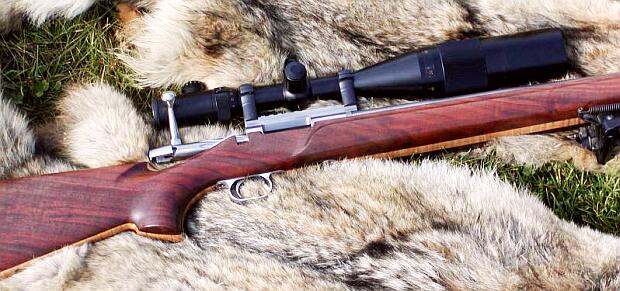
Load Development and Accuracy
Working up a load for this rifle was simple. Richard tells us: "I've been shooting the 6mm Rem AI for over 15 years. Whenever I build a new one I start with the 75gr Hornady V-Max, seated pretty far into the lands, pushed by 51 grains of Vihtavuori N160, working up to about 52 grains. N160 seems to be perfect for the case, yielding great velocity (about 3860 fps) and excellent accuracy. This gun is a 14-twist, and I normally shoot the 75gr V-Max. As far as I'm concerned, the 75gr V-Max is the best factory bullet you can shoot. It's the most consistent, with a better BC than other brands in the same weight range. But to get a 75 to stabilize in a 14-twist, you have to really boot 'em out there fast--you need to smoke 'em out at 3750 fps or better. The faster you push a 75 the better it's going to shoot.
I've also tried the 65gr V-Max. It gives great velocity, but it doesn't have the BC of the 75-grainer. With the 65, I recommend 47.5 grains of Varget or 47.5 grains of IMR 4064. Both of those loads will push a 65gr V-Max about 4,100 fps. Some 6mm Rem AI shooters prefer to shoot the 87gr V-Max from a 10-twist barrel.The 6mm Rem AI set up with a 10-twist barrel to shoot the 87gr V-Max is about the ultimate long-range varmint caliber one could ever want. With a BC of about .400, the 87gr V-Max is a great performer out past 600 yards where it will surpass the 65gr and 75gr V-Max. It cannot be launched as fast as a 75-grainer. The 87 starts out a little slower but at 1000 yards it is going faster, hits harder and is flatter shooting than the lighter V-Maxes. (Note: the loads mentioned here are all fairly stout; they may be too hot for your rifle and your conditions. ALWAYS START 10% LOW and work up.)
But overall, I prefer the 75-grain V-Max over its heavier and lighter breathren. The 75 offers the best balance between velocity and BC. We varmint hunters like very high velocity for a flat trajectory and explosiveness (the "red mist" effect) on the target. With the 75 you can use a slower twist, and that means less drag in the barrel. So the slower the twist, the faster you can shoot. Keep in mind, however, that not all 14-twist barrels will stabilize the 75s. I've found that some 14s just won't shoot them fast enough to stabilize. I can't really tell you why--it could be that the twist rate is slightly slower than claimed, or it could be the bore diameter is a little tight. Every barrel is different. If you want to be safe, go with a 13-twist. My 14-twist works great with the 75s though, and I feel I get more speed with a 14 versus a 13-twist.
One last thing about bullets. I've tried the Noslers and I'll stick with the Hornadys--they're much more consistent, and they're more accurate for me. Some folks have tested Noslers and V-Maxs with a Juneke machine and they found a higher defect rate with the Noslers. You'll have more bad Ballistic Tips in one box than in several boxes of V-Maxs. You can't beat the V-Max for accuracy. As far as primers go, I use Federal match primers, with the exception of using CCIs in hot loads in small cases such as the BR and PPC families of cartridges. The CCIs will not pierce as easily as the Federals.
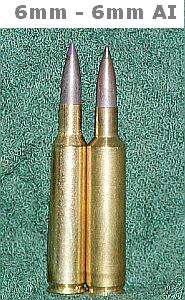 Case-Forming the 6mm Rem Ackley Case-Forming the 6mm Rem Ackley
In the past I've used Winchester 6mm Rem brass. I have found Winchester 6mm Rem brass to be more consistent than the Remington-headstamp brass. I have a .274" no-turn neck, so with Winchester brass I could just load and shoot--the case forms fine with no special tweaking. Recently, however, I've switched to Norma 7x57 brass. This takes more work to form, but I think I get more consistent brass in the end--and it lasts a bit longer. Making the brass is a three-stage process. First I run the cases through a 6.5-284 die to just touch the neck and bring the neck diameter down. Next I run the brass through a 6mm Rem Ackley Improved die. But with the Norma 7x57 brass, that leaves the necks a little thick for my .274" chamber. So then I'll neck-turn, taking about .003" off the neck-diameter, ending up at about .271". I'm real happy with the Norma brass so far. The primer pockets seem to hold longer than the Winchester and the accuracy may be a bit better. Once Ackleyized, with the 40-degree shoulder, the cases are very stable. I never have to trim them to length--the cases just don't stretch. I'll get 10-15 loads over the life of the case, during which I may have to bump the shoulders two or three times. Normally I can shoot one set of cases all summer."
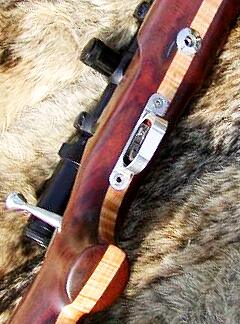 Stock Details--Bedding and Finishing Stock Details--Bedding and Finishing
Richard tells us, "A good bedding job is as critical to accuracy as the best barrel money can buy." For a pillar-bedded rifle, Richard begins by turning stainless pillars from sections of cast-off barrels. It takes him half an hour to make a single pair of 1/2"-diameter pillars with a 7/8" bottom flange or "escutchen" (see forward pillar base in photo). He mounts the pillars in the stock with Devcon, then relieves wood from the stock interior to provide fill space for a Devcon coating under the entire action. His pillar-bedding work is exceptional--the man really knows his stuff. A two-bolt installation costs $140, while a three-bolt job is $20 more. Costing $40 per set, the stainless pillars are only available to customers who purchase his stocks.
Richard offers a variety of finishes, but for this rifle he used a hand-rubbed oil finish over 10 coats of clear. After applying the clear-coat, he spent about three hours rubbing the finish with #0000 steel wool. This dulls down the shiny gloss. Then came the labor of love. He applied WATCO Danish oil liberally to the stock with his fingers, removing the excess with paper towels. Rubbing out with the towels smooths and polishes the wood. The end result is a handsome satin finish that looks like a classic all-oil finish, but is much more durable since the undercoat is epoxy clear. Richard tells us: "It takes a lot of time, but the end result is worth it--you end up with a beautiful finish that is much tougher than oil alone."
| The World of Fancy Laminates Richard Franklin is one of the few men in America who sells strong, beautiful stocks laminated from fancy hardwoods. To accomplish this, Richard had to be an engineer as much as a woodworker. He designed his own stock duplicator as well as a gluing press that uses three twenty-ton hydraulic rams. This allows him to laminate hardwoods with no visible gluing seams. Richard explains: "Glue lines can ruin a beautiful stock". Richard is modest about his operation, but he really is doing something unique. His technology allows a customer to enjoy the beauty and elegance of presentation-grade hardwoods, with the stability and stiffness of laminated wood.
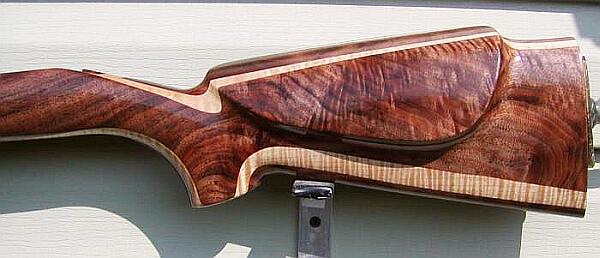 Conventional laminated stocks are made from multiple layers of dyed Birch hardwood which is very dense. This can make an exceptionally strong stock. They are available in many combinations of colors, some really nice and some really wild, but they all have a distinctive utilitarian look as compared to Richard's laminates made from fine woods such as straight-grained Walnut, Curly Walnut, Curly Maple, Osage, Wild Cherry, and Brazilian Cherry. Richard tells us: "For the 10.5-pound BR rifle I have found that the Eastern Red Cedar is about the only wood that will make weight in my model BR2000 stock." Richard's hardwood laminates can mimic a classic one-piece stock. While he normally uses 5- or 7-layer laminates, when he has a really spectacular piece of wood Richard uses a 3-part laminate, with the left and right sections cut from a single block: "When I do anything out of real fancy wood, we want all the finely-figured wood to show on the outside, so we'll use three laminates. Three laminates makes it much stiffer than a conventional one-piece stock, but it will look like a one-piece stock, with perfectly matched sides. A three-layer stock will never warp or move, and it will shoot as good as 10 layers. When working with the best blanks, you have to get a happy medium between number of lams and the beauty of the stock."
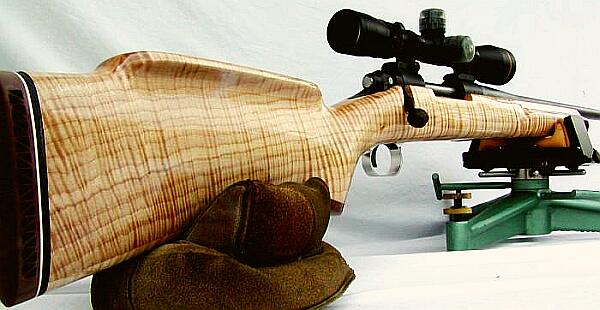
Richard employs a variety of fine woods, Walnut (Claro, Bastogne, English), Cherry, Curly Maple, Birdseye Maple, and Cedar to name a few. For his premium stocks, he's always looking for a superior piece of wood. He acquires a lot of his blanks from Northwest Timber in Washington state, but now and then he'll go out and fell a tree. He tells us: "it takes a huge amount of time and effort to cut your own wood. I'll usually only do this if I can find an original growth tree with a thick trunk and lots of crotch and burl in the base. Walnut Burl is rare. It's hard to find one that is long enough to make a gunstock. When I fall a Walnut or Cherry tree I buck it into four-foot logs and then haul them home to be immediately sawn on a bandmill into blanks usually measuring about 4" X 10" X 40". These will be air-dried for about two years and then taken to a local kiln which will further reduce the moisture content to about 8%. The best figure in the butt area comes from a blank that is cut from deep into the stump. This requires a lot of work and causes many dull blades and chainsaw chains. The next best figure comes from a crotch-cut blank (two intersecting limbs) of sufficient size. You want no heartwood or sapwood in your blanks. With Curly Maple, the most desireable figure displays numerous, smaller stripes in the wood that are very consistent the full length of the blank."
 Richard is a strong advocate of wood stocks for performance as well as aesthetics: "Wood is much easier on the eyes. It feels better in your hands and shoots better than a hard, rigid glass stock. I would never own a glass stock for a match rifle. I believe most rigs will shoot better in laminated wood. Fiberglass can be just as brittle as a pane of glass. Fiberglass can transfer vibrations back into the barrel, so the gun hums like a tuning fork. Wood is more dense than fiberglass so a wooden stock dampens vibration better. The only reason I'd want a synthetic stock would be for elk- or bear-hunting in the mountains, where durability is your main concern. For that, I'd want something like an HS Precision. Richard is a strong advocate of wood stocks for performance as well as aesthetics: "Wood is much easier on the eyes. It feels better in your hands and shoots better than a hard, rigid glass stock. I would never own a glass stock for a match rifle. I believe most rigs will shoot better in laminated wood. Fiberglass can be just as brittle as a pane of glass. Fiberglass can transfer vibrations back into the barrel, so the gun hums like a tuning fork. Wood is more dense than fiberglass so a wooden stock dampens vibration better. The only reason I'd want a synthetic stock would be for elk- or bear-hunting in the mountains, where durability is your main concern. For that, I'd want something like an HS Precision.
Yes I know many records have been set with fiberglass stocks, but I think that will change with our improved designs and wood lamination technologies. Terry Leonard and others are producing superb wood stocks and more benchrest shooters are going to wood now. With more nice wood benchrest stocks available, you'll see more matches being won with wood. Certainly in the 1000-yard benchrest game, more and more top competitors are demanding wood these days." For more information, contact:
For Rifle Building
Richards Custom Rifles
10433 Stewartsville Rd.
Vinton, VA 24179
email: customrifles[at]hughes.net
phone: (540) 890-8649 | For Custom Wood Stocks
West Custom Rifles (Greg West)
1052 Slow Walk Drive
Vinton, VA 24179
email: greg[at]westcustomrifles.com
phone: (540) 890-9245 |
Did You Enjoy Reading this Article? If So, You Can Help Support
6mmBR.com by Making a Small, Secure Contribution.
Photos Copyright © 2005 Richard Franklin, All Rights Reserved. All other content and design Copyright © 2005, 6mmBR.com, All Rights Reserved. No reproduction of any content without advanced permission in writing.
Topics: Precision rifle, hunting, varmints, varminting, groundhog shooting, rifle accuracy, 6mmBR, 6BR, 6 Dasher, .243 WSSM, 6mm Remington, Ackley Improved, 6 REM AI, Vihtavuori, N160, VV N160, Varget, IMR 4064, Laminated stocks, BAT custom actions, Krieger barrel, Harrel muzzle brake, Jewell trigger, Maple, Curley Maple, Walnut, Laminated Walnut, training, reloading, powder selection, case forming, fire-forming, Lapua Brass and Hornady bullets, moly coating, gunstock, stock-making, wood working.


|
|
|